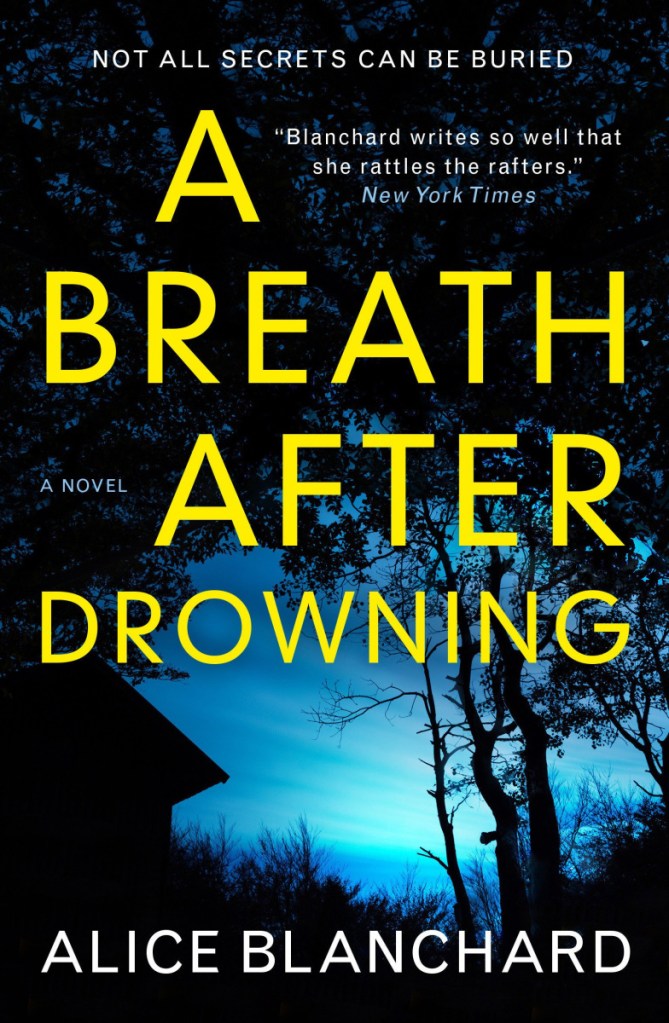The title of Alice Blanchard’s newest thriller, “A Breath After Drowning,” still confuses me. Of course, part of the point in formulaic thrillers is to confound the reader, at least up to the big reveal. The novel starts in Boston, and ends in the wilderness of Maine, where a showdown with a killer and the dangers of hypothermia create a thrilling narrative climax. Along the way, the red herrings are numerous and make up the most satisfying facet of the novel.
The novel’s protagonist, Kate Wolfe, is a psychiatrist, a classic and much beloved profession in thrillers. Specifically, she is a child psychiatrist, apparently specializing in youth, since the only patients we witness her with are the 16-year-old bipolar Nikki who opens the book, and the 14-year-old Maddie, with whom Kate shares a shocking connection.
Again, as in many thrillers, the reason for Kate’s career choice, as well as the center of her personality, is a series of terrible childhood traumas – unfortunately, we get little substance to Kate otherwise, as if her suffering as a child is enough fodder for a well-rounded character. When Kate was ten, her mother, Julia, killed herself after a lengthy stay at a psychiatric institution. When Kate was 16, her little sister was kidnapped and murdered, buried alive in the backyard of a neighbor named Henry Blackwood. Maddie’s mother is, not incidentally, Henry’s niece.
Everything is entangled in the novel early on, which makes Blanchard’s misdirections work well. Soon after Maddie is admitted to the psychiatric hospital in Boston where Kate works, Kate realizes that the timing is suspicious: Henry Blackwood is set to be executed, and Maddie’s mother, who provided the damning testimony that convicted him and sent him to death row, is now recanting. Could she have sent the sympathetic, wide-eyed Maddie as a manipulative tool? Meanwhile, Kate also has to cancel a long-planned trip with her boyfriend after her patient Nikki commits suicide. What’s more, at Nikki’s funeral, Kate meets a retired police detective who’s not only convinced that Henry Blackwood is innocent, but that there’s a serial killer on the loose, who may actually be responsible for Kate’s sister’s murder.
The plot is engaging, and throws enough misdirection at the reader to ensure that even if you thought you knew whodunit at first, you will doubt yourself again and again. But the book’s inconsistencies are disappointing: it includes a host of wild inaccuracies, several bizarre dialogues that don’t track, and it manages in equal measure to malign and idealize severe mental illnesses. For instance:
“There was something disturbingly truthful about the mentally ill. They had the kind of clarity that most people lacked, an ability to cut through the (expletive) and say exactly what was on their mind, no matter how warped or confused. Even their delusions were layered with meaning and truth.”
This clichéd and infuriating romanticization implies both that mental illness is a uniform state within which delusions are de rigueur and that being rude is par for the course. Kate’s boyfriend, also a psychiatrist, tells her early in the novel that she’ll “fix” some of her patients, but not all, and Kate doesn’t correct him; later, Kate tells the young Maddie, “Actually, psychiatrists aren’t supposed to fix people.” Perhaps this is sloppy editing more than the author’s fault, as there are several such moments where the characters emphatically state one thing but then end up protesting and saying another with zero irony or self-awareness.
And that’s not all. Kate’s path towards psychiatry is disturbing. Her mentor is an older psychiatrist named Ira Lippencott:
“Ira had been her senior attending and knew about all about the tragedies that had shaped her life. As an undergraduate, she’d undergone psychoanalysis with him as her therapist. It was a prerequisite. ‘You need to know what it’s like to sit in the other chair, before you can sit in my chair,’ he’d explained.”
But no psychiatrist teaching or treating an undergraduate would require her to undergo psychoanalysis. Yes, therapists-in-training are required to be in therapy themselves, but this would occur during graduate education or med school. And their therapists would certainly not also be their mentors later on.
Additionally, Kate insists on continuing to treat the young Maddie even though the girl’s uncle was convicted of Kate’s sister’s murder – this, like Lippencott’s mentorship, crosses a thick red ethical line. The trouble with such misrepresentation is that, for one thing, it may make even the casual reader assume an unethical core within psychiatry, even among these characters who are meant to be passionate. For another, any reader with an understanding of the profession will be yanked out of the suspenseful reality of the novel by the inaccuracies, impatient with what should have been easily avoided mistakes for Blanchard. Yes, this is fiction, but when elements of a story are easily discredited, it’s harder to suspend disbelief over the whole.
Despite its inaccurate representations of the psychiatric field, the novel is a fast-paced read written in the style of many easy-to-digest psychological thrillers. Except for rare moments, the characters show little personality (when James drunk-buys marshmallows, for instance; when Kate attempts to fight off judgment of Maddie’s mother), but this isn’t necessarily what we pick up thrillers for. We read them for the suspense and the guesswork and the swift-moving plot. To be fair to Blanchard, she succeeds at these elements.
Ilana Masad is a book critic and fiction writer attending doctoral studies at the University of Nebraska-Lincoln. Her work has appeared in The New Yorker, the Washington Post, the LA Times and more.
Send questions/comments to the editors.



Comments are no longer available on this story